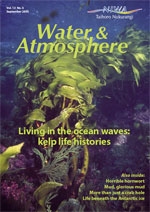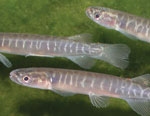PDF of this article (217 KB)


Cindy Baker, Guy Carton, Jared Fine, and Peter Sorensen are investigating whether bile acids serve as chemical cues for whitebait looking for suitable habitat.
The banded kokopu (Galaxias fasciatus) is one of the five species supporting New Zealand’s nationwide whitebait fishery. Like inanga, the banded kokopu is diadromous, migrating between fresh and salt water during its life cycle. Adult banded kokopu live and breed in freshwater; the larvae migrate to the sea when they hatch and return to freshwater as juveniles or 'whitebait', in search of habitat to grow to adulthood.
Recent work suggests that migratory banded kokopu juveniles may use chemical cues released by resident adults to select rivers and streams containing suitable adult habitat. Such cues are commonly known as pheromones and are used by many species of fish as well as other vertebrates, including humans. Pheromones are renowned for being specific and potent, and offer the advantage that they can safely be added to waters to attract juveniles and enhance native fisheries. The trick is to identify the pheromones that work for a species.
Bile acids are chemical compounds produced by the liver and stored in the gallbladder. They are released to aid digestion and are excreted in urine and faeces. Bile acids are potent olfactory stimuli in fish, and recent findings show they (and related products) function as both sex and migratory pheromones in the sea lamprey Petromyzon marinus.
Like a lamprey
The northern hemisphere sea lamprey is the best understood example of how pheromones assist migration in a fish, and may shed light on banded kokopu migrations. Migratory adult sea lamprey, living in the Great Lakes of North America, are known to select spawning streams based on the presence of a pheromone released by larvae in the stream. The pheromonal cue is composed of many compounds, including the bile acid petromyzonol sulphate (named after the lamprey). The olfactory system of an adult lamprey can detect this bile acid at picomolar concentrations, which is less than 1 g in about 10 billion litres of water.
Our study investigated the possibility that bile acids may play a similar role in banded kokopu migration. To do this we had to determine what bile acids are produced by adult banded kokopu, what bile acids the fish release into the water, and which of these banded kokopu can detect.
Analysing and detecting bile acids

To determine the bile acids produced and released by banded kokopu, we used high-performance liquid chromatography (HPLC) and mass spectrometry (MS) to analyse the gallbladder and liver of the fish and 'release water' from a tank in which the fish had been held. Then we made electrophysiological recordings from the noses of banded kokopu to determine which bile acids they could smell. These recordings are called electro-olfactograms, or EOGs.
Our HPLC analysis indicated that the liver and gallbladder extracts from banded kokopu contained two main bile acids: TCA and TCD (see table below for the full names). A third bile acid, 5α-CS, was found in very small quantities, but only in one sample. The release water of adult banded kokopu also contained TCA and TCD, but did not have any detectable 5α-CS. In addition, we found three peaks in the HPLC analysis that were unknown chemical compounds.
To determine how banded kokopu detect bile acids, we first tested 30 bile acids in six groups. When a group of acids produced significant responses in the electro-olfactograms, we tested those bile acids individually. This gave 15 bile acids that were tested alone (see table). After standardising the fish responses to account for individual differences, we found that only 5 bile acids gave significant responses. These were 5α-CS P, PS, ACA, and TCA.
And the verdict is ...
Each of the galaxiid whitebait species has different habitat requirements. Laboratory studies have demonstrated that juvenile banded kokopu are attracted to adult pheromones from their own species. Juveniles can discriminate and are attracted to water conditioned by adult banded kokopu over that of other galaxiid species.
Our findings suggest the two known bile acids produced and released by adult banded kokopu – TCA and TCD – are unlikely to function as a specific migratory pheromone for juvenile banded kokopu. This is because both TCA and TCD are common among fish and are not species-specific. They are the main bile acids found in bile, faeces, and urine of many fish species and are probably common in the environment. Although the olfactory system of banded kokopu was highly responsive to 5α-CS, it is produced in very low quantities by fish and was not found in the fish holding water. Therefore, it is also unlikely to be functioning as a migratory cue. However, we did find three novel compounds in the release water of adult fish that have not been identified in other fish species. The next step in our investigation will be to isolate these novel compounds and determine if they function as a migratory cue for juvenile banded kokopu.
| Abbreviation | Common name |
|---|---|
| PS | Petromyzonol sulphate |
| ACA | Allocholic acid |
| P | Petromyzonol |
| CA | Cholic acid |
| CAS | Cholic acid 3-sulphate |
| TCA | Taurocholic acid |
| GCA | Glycocholic acid |
| CDC | Chenodeoxycholic acid |
| GCD | Glycochenodeoxycholic acid |
| TCD | Taurochenodeoxycholic acid |
| TCL | Taurocholanic acid |
| GCL | Glychocholanic acid |
| DHC | Dehydrocholic acid |
| DCH | Deoxycholic acid 3-acetyl methyl ester |
| 5α-CS | 5α-Cyprinol sulphate |
The 15 bile acids tested in EOG recordings.
Homing in with pheromones
- Pheromones are the chemical cues that can guide migrating fish to find their own kind.
- Studies with sea lamprey have shown that bile acids are a key pheromone for that species.
- Lab studies with bile acids found that they are probably not the key ingredient for banded kokopu, but three unidentified compounds may hold the answer.
Dr Cindy Baker is a member of the freshwater fish team, based at NIWA in Hamilton. Dr Guy Carton is in the School of Biological Sciences at the University of Auckland, and Dr Jared Fine and Dr Peter Sorensen are with the Department of Fisheries, Wildlife, and Conservation Biology at the University of Minnesota.
The experiments were approved by the Institutional Animal Care and Use Committee of the University of Minnesota, where the study was conducted.
Author contact: [email protected]
Teachers’ resource for NCEA AS: Biology 90462 (2.6), 90717 (3.5), 90718 (3.6). See other curriculum connections at www.niwa.co.nz/pubs/wa/resources
